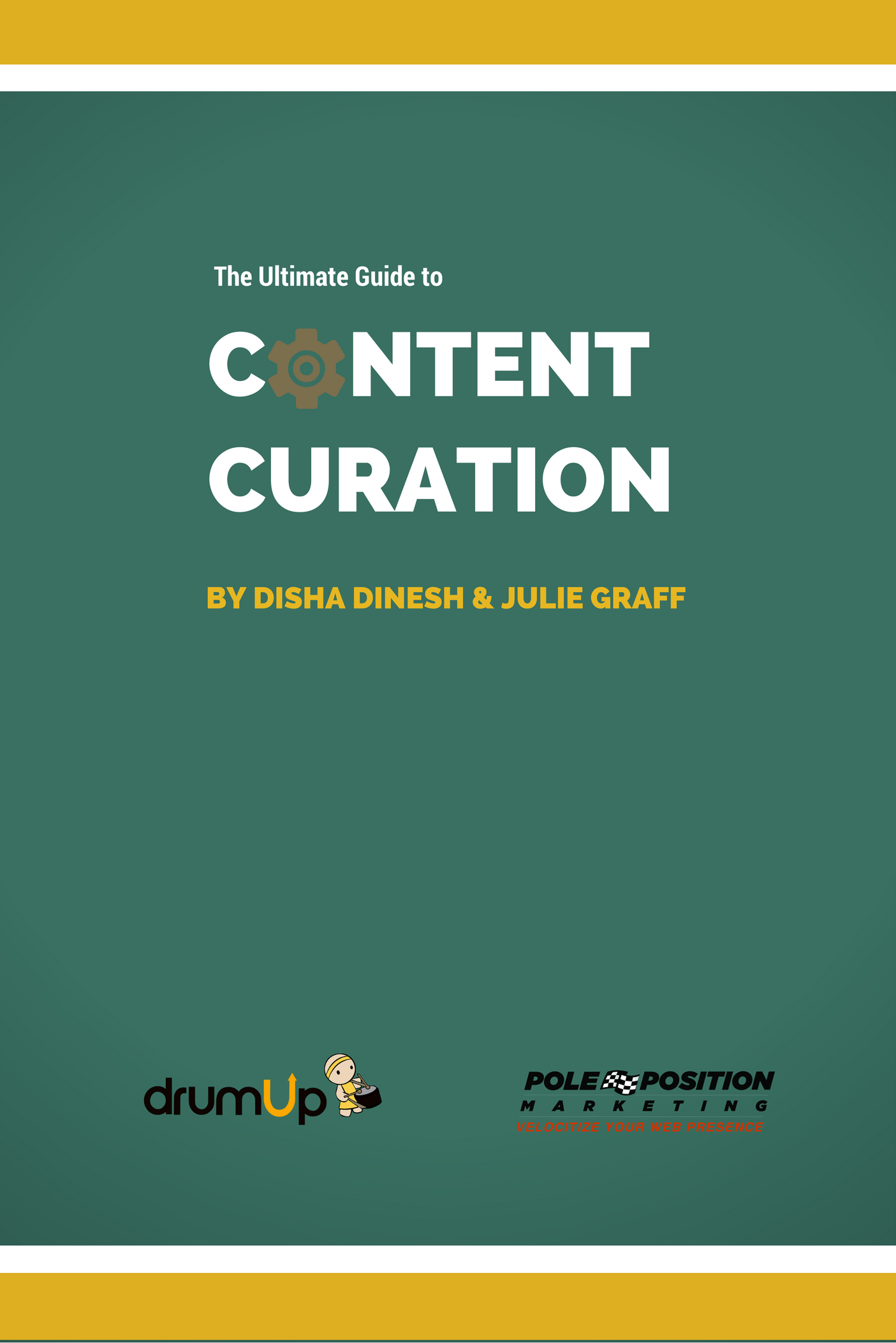The Ultimate Content Curation Guide for Social Media
As social media managers or small business heads, do you struggle with keeping your social media accounts updated for your audience? Are your upset that your social media profiles don’t appear as visually and intellectually appealing as you want them to be?
Here’s something you’ve probably not considered.
Your followers, and all social media users are also posed with a problem. They struggle with seeking out relevant and useful information to answer their questions.
You could solve your problem while also solving theirs with a simple and effective fix: content curation.
Content curation is the practice of finding the best stuff in a niche’ and serving it up on your platform for your readers’ benefit. Serve honey and the bees with love you for it.
You could play the role of the seeker, filter content, and serve up only what’s relevant to social media users. Be the funnel.
By doing that you make yourself useful to social media users who are interested in your area of expertise. They get the information they need, you acquire grateful and loyal followers (potential customers), your social media walls get populated with high-quality, class content, AND you can save the time it would have taken you to create content of equivalent quality.
Everybody’s happy. Including the person whose content you’ve shared. In fact, these are just some of the benefits of content curation.
Why you should curate content for social media
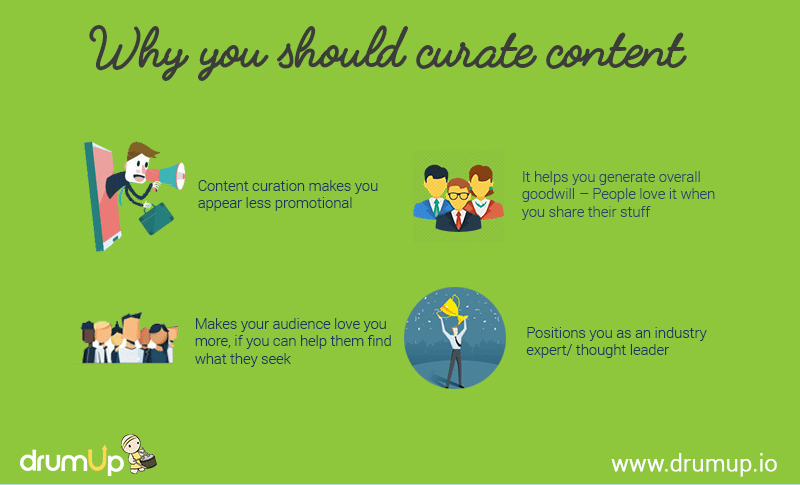
6 straight-out benefits of social media content curation
1. Establish trust as a thought-leader: Curation of high-quality content makes your audience perceive you as an industry expert, and as a go-to source for information
2. Nurture potential leads: Ultimately, maintaining an active and useful presence on social media is what will keep you at the top of users’ minds when they’re ready to buy
3. Save on time and effort: Time is invaluable in building and marketing a business, and content curation saves you time while maintaining your social media activity
4. Become a favorite go-to page: The audience loves social media profiles that consistently share great content, and are more likely to passionately follow such accounts
Content curation fills the engagement gap
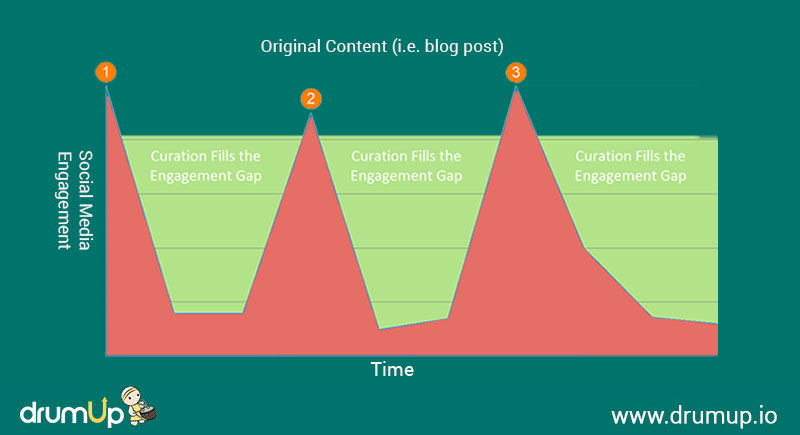
5. Avoid being written-off as promotional: Nobody likes people who only talk about themselves, and content curation makes you appear less promotional and commercial
6. Build valuable relationships: People love when you share their content, and sharing is an effective way to network and build connections on social media
Statistics that represent the importance of content curation
In 2013, SINTEF ICT stated that the world had generated 90% more data in the previous two years than it had in all of history. In this age, it is more pertinent to assist people in locating useful and relevant information than it is to go around creating more content.

1. In a study conducted by Content Marketing Institute, 77% of the participants said they would curate more content in 2016 than they did in 2015.
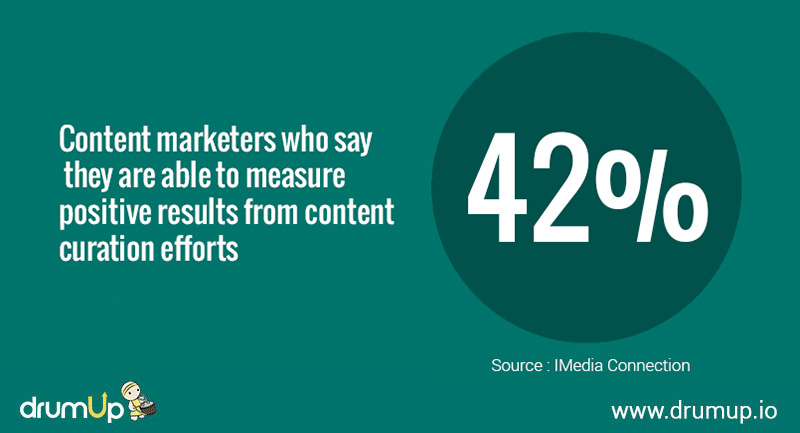
2. 42% of marketers who participated in a study confirmed that they are able to measure positive results from content curation efforts.
Your competitors are leveraging the advantages of including content curation in their marketing mix. Are you?
5 key steps to curating excellent content
Effectively, content curation is a straight-forward process – you find great content and share it, but to maximize on the benefits it could provide, you have to take a more organized and strategic approach. It’s useful to have a system in place for a consistently improving content curation cycle.
The following is a list of five steps integral to successfully curating content.
1. Outline your niche
Bees to honey. Remember to be careful about the content you curate because –
a. It reflects on you and impacts your professional image on the internet
b. It decides the type of information seekers you attract to your blogs/social profiles
You could have a million people clicking on your social media post, but unless they fit your high-potential buyer persona, your conversion numbers will weigh on the lower side.
Look at it this way, there are several terrific writers and technical experts in your narrow, specific niche out there, but your audience certainly doesn’t have the time to identify them and follow them on a daily basis. So if you curated their content and made it all available on your social media pages, they could just follow you and find everything they wanted.
To make that possible, you first have to define your niche. Specify your keywords.
Note: Keep your audience’s interests in mind when outlining your niche.
For instance, DrumUp is a social media management and social media content curation platform. But we also have an employee advocacy module to help amplify your social media shares. Our audience could include a mix of social media marketers and businesses that use social media for marketing.
So our niche would include – multiple account social media management, Facebook, LinkedIn and Twitter trends, updates and strategies, content curation and employee advocacy trends, updates and strategies.
2. Identify credible sources
The better the quality of content you curate, the more credible you become as a reference point for useful content. It’s also an added advantage if you can reach into the abyss and pull out great content that is not easily discoverable.
Out of the millions of pieces of content uploaded to the internet everyday, several valuable ones get buried. So as a content curator, you should ideally be able to identify all the sources for content in your industry that are credible and reliable in terms of producing accurate, authentic and fresh content.
Your list should be exhaustive and inclusive of all the best creators of content in the industry. On your list you should have news agencies, newsletters, content agencies, social media influencers, bloggers, and independent industry experts. In many cases these roles overlap and you’ll find people who belong to all of these categories.
Alternatively, you could use an intelligent content curation app like DrumUp to do the search and discovery for you so you can share pertinent social media content via all your social media accounts.
Using social media content curation apps saves you a lot of time otherwise spent of manually discovering content. You’re awesome, but you have to admit that a smart algorithm can help improve you results quite some.
3. Curate and create a digital collection
Once you have your objectives and topics listed, you’re all set to curate awesome content.
Note: Always provide proper attribution when curating someone’s content.
Before you share, ensure that you have answers to each of these questions.
Q #1: Who’s my audience?
Ask yourself this question each time you share something. If you’re curating content to nurture potential leads, the articles you share should directly address one or more than one of your buyer personas. Do they have something to gain from the shares you’re making? Are you telling them something they don’t already know?
Note: Just to elaborate, buyer personas refer to representations of your ideal buyers that you have formed based on market research and surveys
Q #2: Do my shares align with my views?
You cannot curate content that contradicts your views. Your audience forms opinions of your ideals and preferences based on what you share with them. Curating inconsistent and contradicting views will confuse your audience and upset their idea of you.
Q #3 Are my sources credible?
Curating incorrect or poorly represented information is detrimental to your professional image. Verify your sources and be confident of the information you are sharing with your audience. You also do not want to share ideas that won’t help you audience make any progress or add to their knowledge in any manner. Such shares are of no value and consequence.
Q #4 Are my shares diverse?
While it is important to follow a theme so as to attract a very specific audience, it is also necessary to introduce some variety in terms of formats or topics once in a while. It’s good to come in from the left field for strategic breaks in your content curation plan. You don’t want your followers to get bored of you.
Q #5 Are my shares unique?
Even if you’re curating content, lend it your own voice. Add commentary, your opinions about the ideas stated by the author, mention something the author might have missed out, or if you’re simply sharing the article via social media, you could write your own Tweet to describe it or add your own introduction on Facebook and LinkedIn. Give your audience something that they can expect from only you.
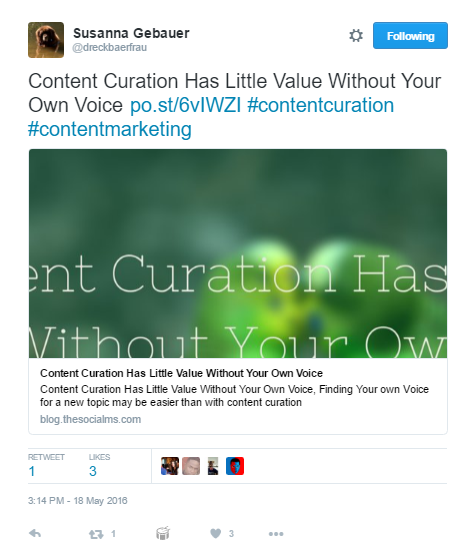
Q #6? Am I curating too much content?
To be considered a thought leader, you have to both recognize and acknowledge great content, and create some master-pieces of your own. Above all, you need to be useful to your audience.
Most expert marketers concur that the ideal scenario would be when 65% of your content is created, 25% curated and 10% syndicated.
You could play around with that percentage to see what works for you best, but curation isn’t a substitute for content creation, only a supplement.
4. Share your collection
Once you have your collected curated on the internet, you have to make it accessible to people. You have to promote it and share it through multiple media.
Social media shares: Create Tweets, Facebook posts and LinkedIn shares to announce your collection to your audience. Share on specific social media groups or communities for more efficient audience targeting. Social media plug ins for easy sharing are both interactive and convenient for your users who come across content that they’d like to share at that instant.
Email newsletters: Build a permission based emailing list to whom you can send content updates. You could collect email ids for the list in exchange for registration or subscription to your blog and site.
RSS Feeds: Really Simple Syndication feeds are just that. Ensure to make your blog and site feeds accessible to your views on the internet. This is a standard format that makes the content you curate available for easy integration with several platforms and tools.
5. Analyze engagement
Observe the engagement that your shares encourage. Are they getting re-shared? Do you have comments on your posts?
Since you’re going to share your content via multiple platforms, you will have access to multiple sets of engagement analytics.
Social media engagement analytics:
Numbers of shares, likes, comments and tone of sentiment are useful to have. You could employ social media analytics tools to ascertain these metrics for you.
Email newsletter analytics:
Unique opens, clicks, shares help provide insight on what is most popular among your audience. Email marketing tools like MailChimp and SendGrid offer access to these numbers.
Google analytics:
If you decide to share your digital collection via blogs or sites, Google can give you useful metrics for your sites and others to help you understand which blog posts are most popular, and which external blogs/sites/social platforms are helping you acquire most of your readers.
Using each of these metrics, you could determine:
a. Which topics to focus on (the ones that are most popular)
b. Which formats to use more often (the posts that get most engagement)
c. Which social media platforms to focus on for promotions (the ones that are giving you most referrals)
d. Which external blogs/sites to work with for more traffic (the ones that are giving you most referrals)
7 types of content to curate
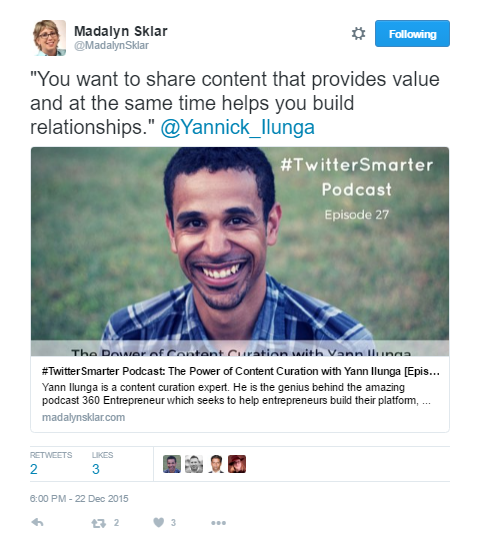
There are largely seven types of useful content you could curate for your audience:
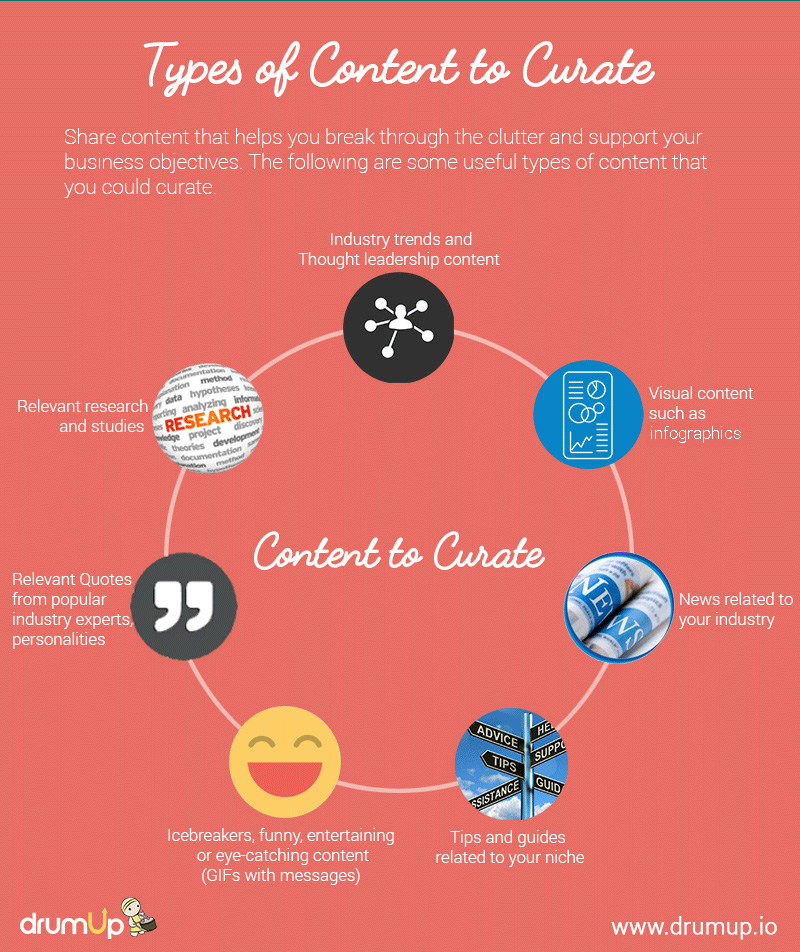
1. Industry trends and thought-leadership content
An important part of being competent is the knowledge of the best, and most up-to-date methods of attacking technical problems in an industry. Inspiring your audience with new and inventive ways of solving problems is an excellent way to earn the identity of being a thought-leader or industry expert. For instance, you could share industry forecasts for each year towards the beginning of that year.
Save time managing your social media accounts
Are you still managing your social media accounts directly from Facebook/Twitter/LinkedIn? Make your life easier by managing all your social media in one place, schedule posts, repeat posts, curate content and more. Try DrumUp now, it's free, forever.
2. News related to your industry
To stay ahead of competition, you have to be updates with developments in the industry. Your audience will appreciate it if you help them do that by curating the news they need to know of.
3. Relevant research and studies
Research is crucial in reinforcing ideas and proving the efficacy of strategies. If you show people which tactics or methods they should use, with strong and reliable numbers to back those ideas, you will develop credibility as a source for ideas that actually work.
4. Tips and guides related to your niche
A large number of people turn to social media for actionable solutions. Tips and guides are practical sources of information that people can use to experience real positive results in their work lives. Curate content that serves that purpose and you’re on your way to becoming a favorite go-to source.
Get DrumUp’s Ultimate Content Curation Guide for Social Media
Prefer to read this offline? We’ve got your covered. You can download the guide from a resource hub our developers just built for you.
Curate strategic content for your brand and watch your audience engagement and brand following grow. Receive your personal copy of the guide from our social media and content marketing resource hub today.
5. Relevant quotes from industry experts
Quotes are popular amongst the social media crowd. You know this if you’ve spent enough time on social media. Pick quotes from industry experts whom you admire and quickly turn them into shareable formats – on simple backgrounds as visuals or with an instant Tweet plugin so they can share it as they read it.
6. Visual content – infographics, graphs, presentations, videos
Your brain process images 10X times as fast as it does text. Images are vital in capturing attention on social media. Find images on free image resources or quickly create your own with easy-to-use and free visual tools to improve the readability of your articles.
Note: You could also curate the occasional GIF to make your dialogues more engaging. To help you do this via DrumUp, our developers have built a GIPHY integration, allowing you to add GIFs from GIPHY to posts scheduled from your dashboard.
7. Icebreakers and entertaining eye-catching shares
Business is serious, most peoples’ work lives are intense and everyone needs a break from it. Provide them with opportunity to break a smile and like you better with fun and casual content. But be careful to ensure you don’t go overboard and be taken less seriously! Share 1-2 of these every 15 or so of posts in other formats and types.
It’s important to space out the serious stuff with casual and fun content, so you can share your personality with your subscribers.
Content curation best practices

1. Use a great application – You’re awesome but probably not as efficient as a good algorithm. Sifting through millions of pieces of content is humanly impossible. Spare yourself the time and effort with a reliable content curation application.
You could also curate content shared by influencers by adding them to Twitter lists. Create public lists if you’d like to share those collections with your followers, and create private lists if you want to track someone without notifying them.
Additionally, industry newsletters function as excellent content curation tools. For marketing, Content Marketing Institute, HubSpot and Brian Dean have interesting newsletters that you can subscribe to for value and variety.
2. Add personal touches – You’re doing the sharing, the app only finds stuff for you. Ultimately, you’re the judge of what goes up on your social media accounts. While the content curation application can serve as a first effective filter, you have to take the call on which ones to share.
If your intent is to become a popular or well-known personality, you have to create a memorable identity for yourself.
Suggested reading: How to position yourself as a thought leader on social media
3. Encourage your audience to share your shares – Spread the love. Content curation gives you and the writer of the article some visibility. Make it simple for your audience to share what they want to. Integrate your blog with social media plug ins and multiple platform share options.
4. Always give credit – Assign credit deserved. Authors put substantial efforts into writing pieces. Each of your shares should provide proper attribution to the original source.
5. Build relationships – Pull people into conversations on social with @ mentions and tags, participate in relevant discussions on social communities
Note: You could use suggested @mentions and #tags when curating content on DrumUp. This is an effortless way to build connections and get noticed on social networks.
Content curation has evolved beyond being a simple tactic. The potential it holds to open new doors and opportunities is extensive. How you apply it matters.
Note: The complete infographic and all images on this post are under the Creative Commons license and are available for reprint. Please attribute this blog with a link while sharing.

Note: This guide was originally published on Jun 22, 2016, and has since been updated with additional information.
